It was a huge, huge, game in week 31 of the Premier League. Manchester City travelled to West London and simply had to win against Chelsea at Stamford Bridge to deny Liverpool the crown for a while longer. After an intense 90-minute battle, Frank Lampard’s team handed an excellent performance to seal all three points.
Pep Guardiola’s tactics were not working and that was the root of their defeat. In this tactical analysis, we will show how Chelsea outplayed Manchester City completely.
Lineups
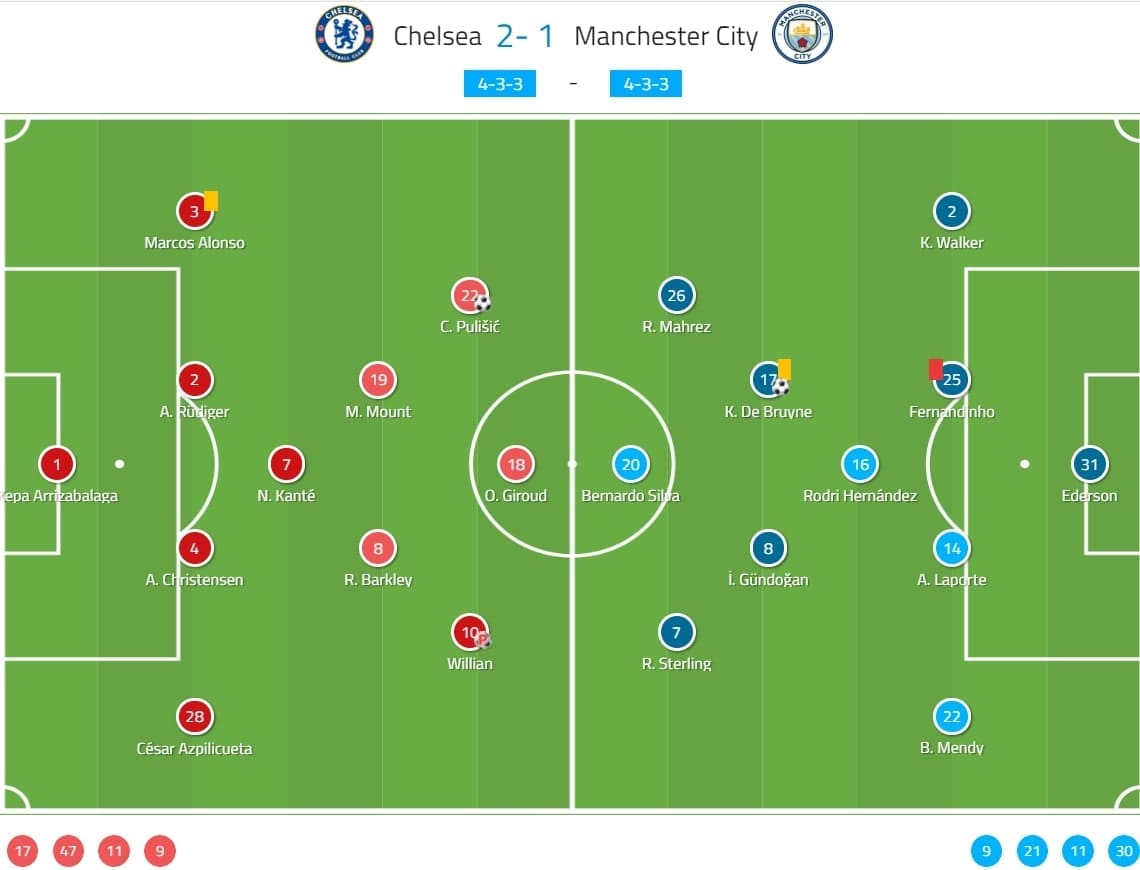
Without Sergio Agüero, Phil Foden and João Cancelo due to injury, City still played in a 4-3-3 but leaving Gabriel Jesus on the bench. Bernardo Silva was the striker on paper. David Silva was another option on the bench as İlkay Gündoğan partnered Kevin De Bruyne at the midfield.
Lampard sent a very strong 4-3-3 to face the champions. Plenty of changes were made after the imperfect performance at Villa Park, Ross Barkley returned to the squad and formed the midfield with Mason Mount and N’Golo Kanté. Christian Pulisic returned to the lineup and played as the left-winger.
Chelsea’s solid midblock
Chelsea’s 29.73 PPDA was high. They spent most of the time in a midblock instead of going out to press. At some points of the game, their PPDA had reached 86 and 91, which were extremely high and similar to Burnley’s figure against City.
However, this disciplined midblock was the key that troubled City a lot. Chelsea formed a 4-1-4-1 block, with Olivier Giroud man-marking City’s pivot: Rodrigo Hernández. Kanté was vital as his presence was the additional layer between the backline and the midfield line. With the French midfielder, City’s behaviour to manipulate the second line was weak as Kanté was everywhere.
By placing the wingers in midfield to shut the central passing routes towards the half-spaces, Lampard wanted City to play the ball out wide and avoid passing the ball to De Bruyne directly.
So, the situation would be as follow: Pulisic and Mount shut the central passing lane, Fernandinho passed wide to Kyle Walker.
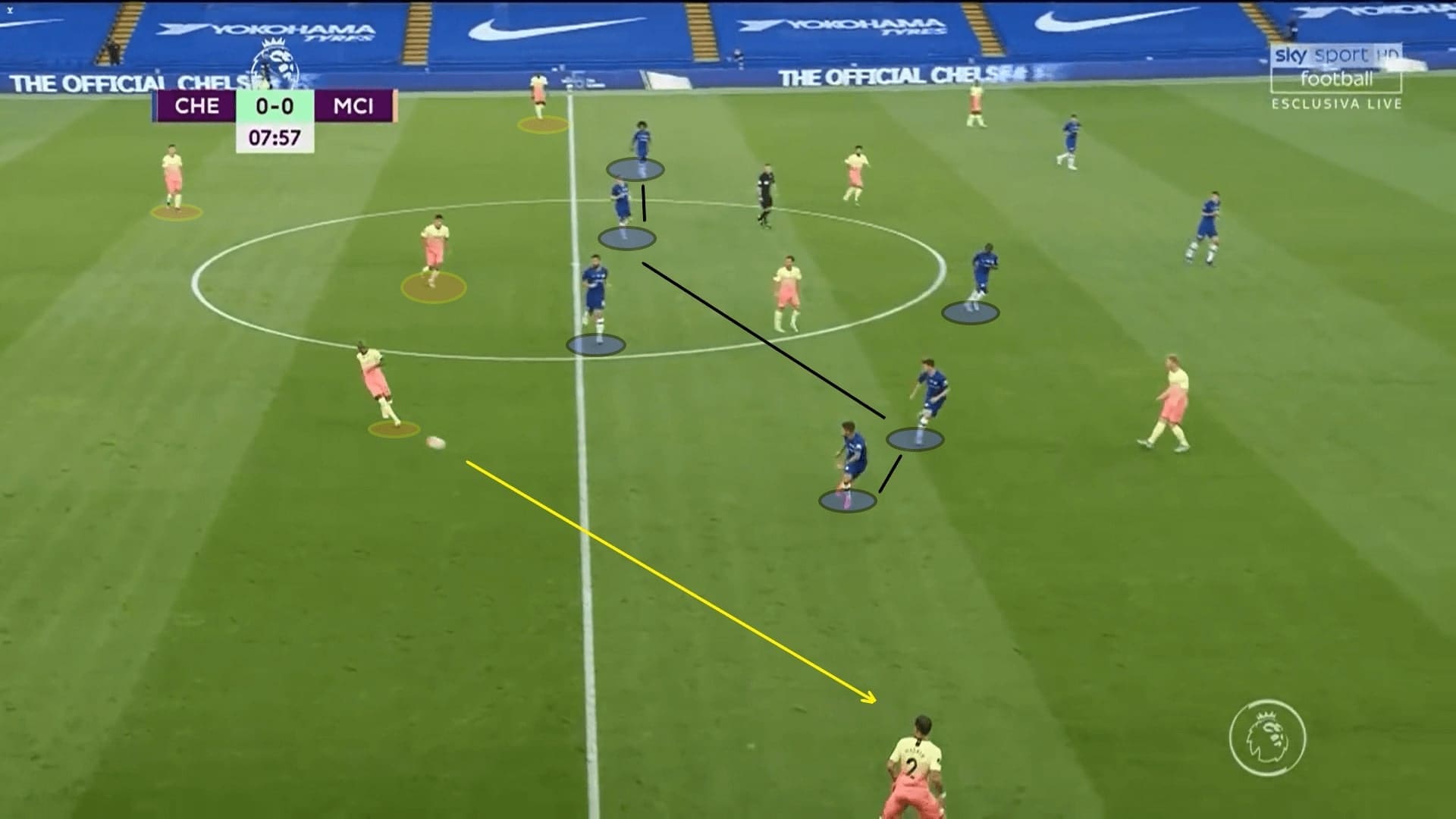
On the flanks, it was vital to constrain Raheem Sterling and Riyad Mahrez. Therefore, Chelsea committed most of the players on the ball side and even the centre-back would step out.
Here, Marcos Alonso engaged Mahrez very early to force the ball back. Since Mahrez was wrong-footed on the right flank, he often received the ball with this body orientation and the early pressure was always a success.
As a defensive cover to Alonso, Antonio Rüdiger moved to the half-spaces to keep B. Silva under control. In general, this was a 4 v 2 numerical superiority for Chelsea and City were unable to progress.
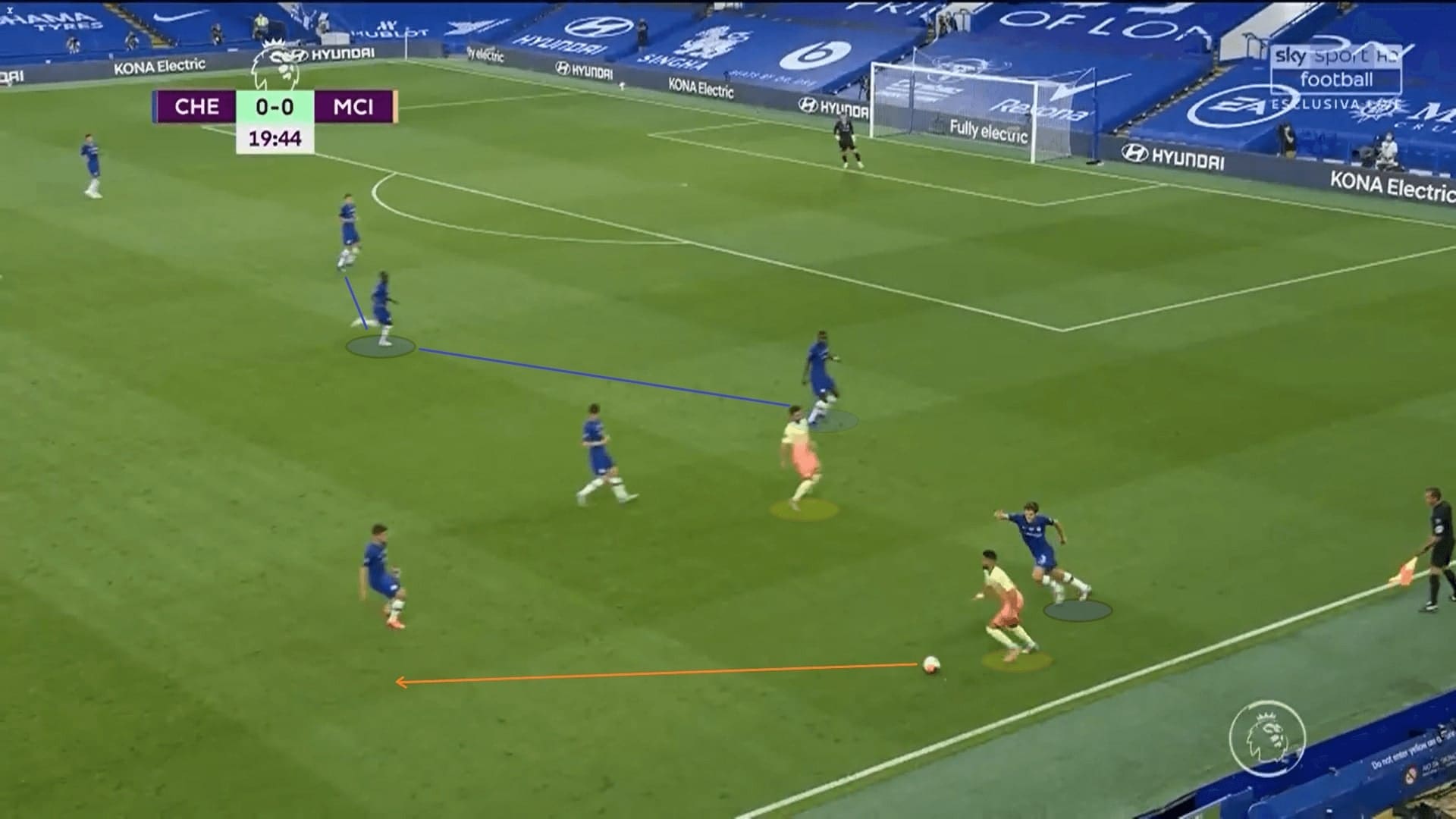
Kanté’s performance was tremendous as he covered all the potential gaps between players. He reduced the gap of the Chelsea centre-backs above. And, in the pressing, if either Mount or Barkley pushed forward to pressure a centre-back, Kanté was also alerted to cover spaces behind at any time. With Kanté, Chelsea compressed spaces quickly, keeping the backline safe.
City need a traditional striker
Guardiola had a difficult task as there was no striker on the field. In the first phase, the inverted full-back system was abandoned as Benjamin Mendy and Walker stayed wide to provide the offensive width. However, this was successful as we mentioned the positioning of Chelsea wingers in the midblock in the above analysis.
Since Rodri was marked by Giroud often, the pressure was kept away from the first line. Fernandinho or even Ederson had their time and spaces to play the out-balls/progressive passes. Here, Fernandinho tried to find the free player, Mendy, at the left-back position.
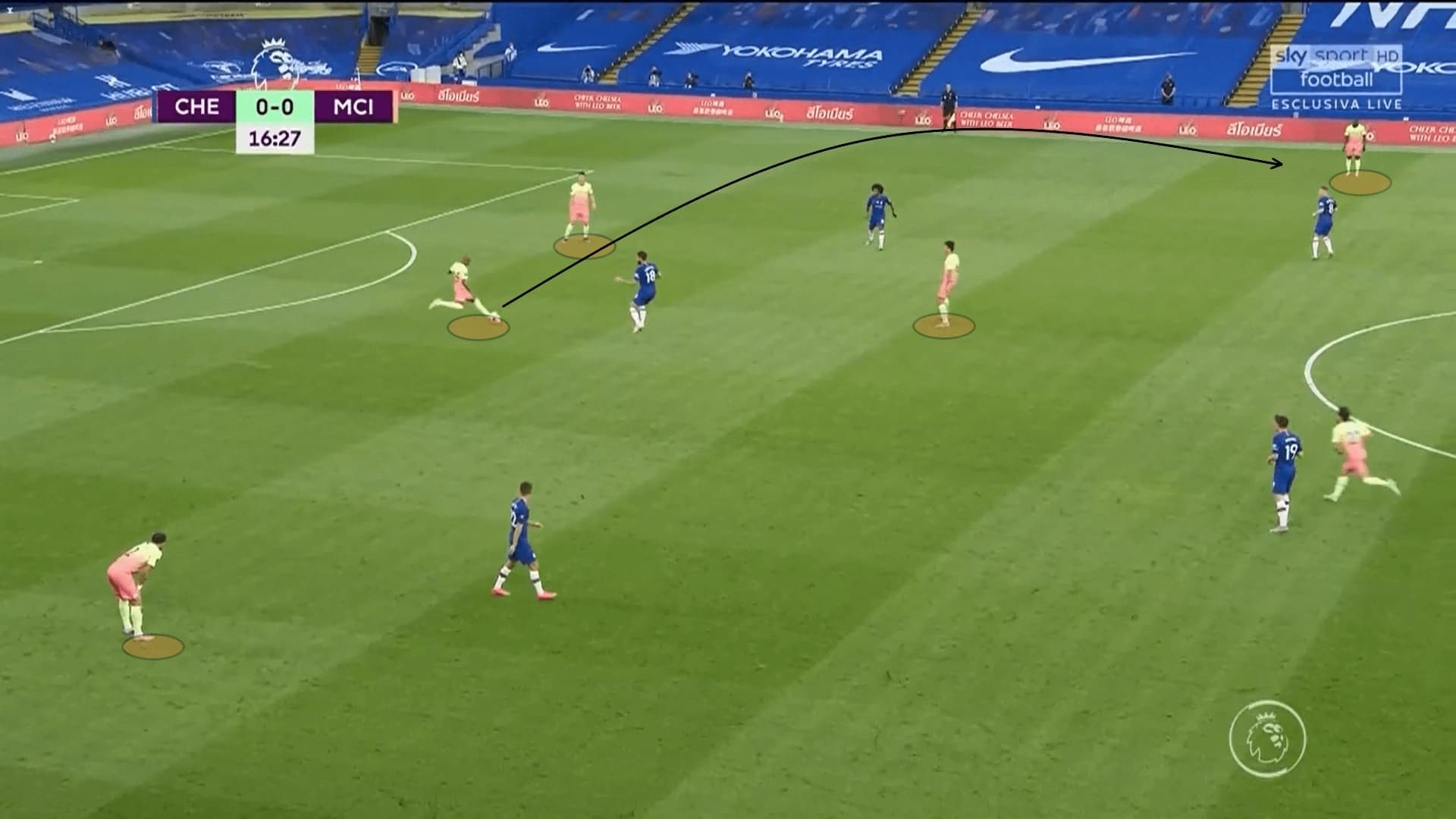
Offensive issue of City in this game was a mix of a mentality problem and one of tactical nature. It seems the away players were not totally ready to seize every chance and look for a win. The passes were sloppy at times and even when a free player was available, he was neglected as City opted for an easier pass.
As an example, Mendy was in a favourable position below. Rodri was keeping Giroud away, Barkley and Willian committed themselves to the wide areas to press. The passing lane to Gündoğan – the free man – was opened. Passing to the German midfielder was significant in this attack as De Bruyne was occupying Kanté already. It was a chance to exploit the dynamics and access the final third.
Disappointingly, Mendy chose the safer option: Aymeric Laporte, which triggered the pressure instantly.
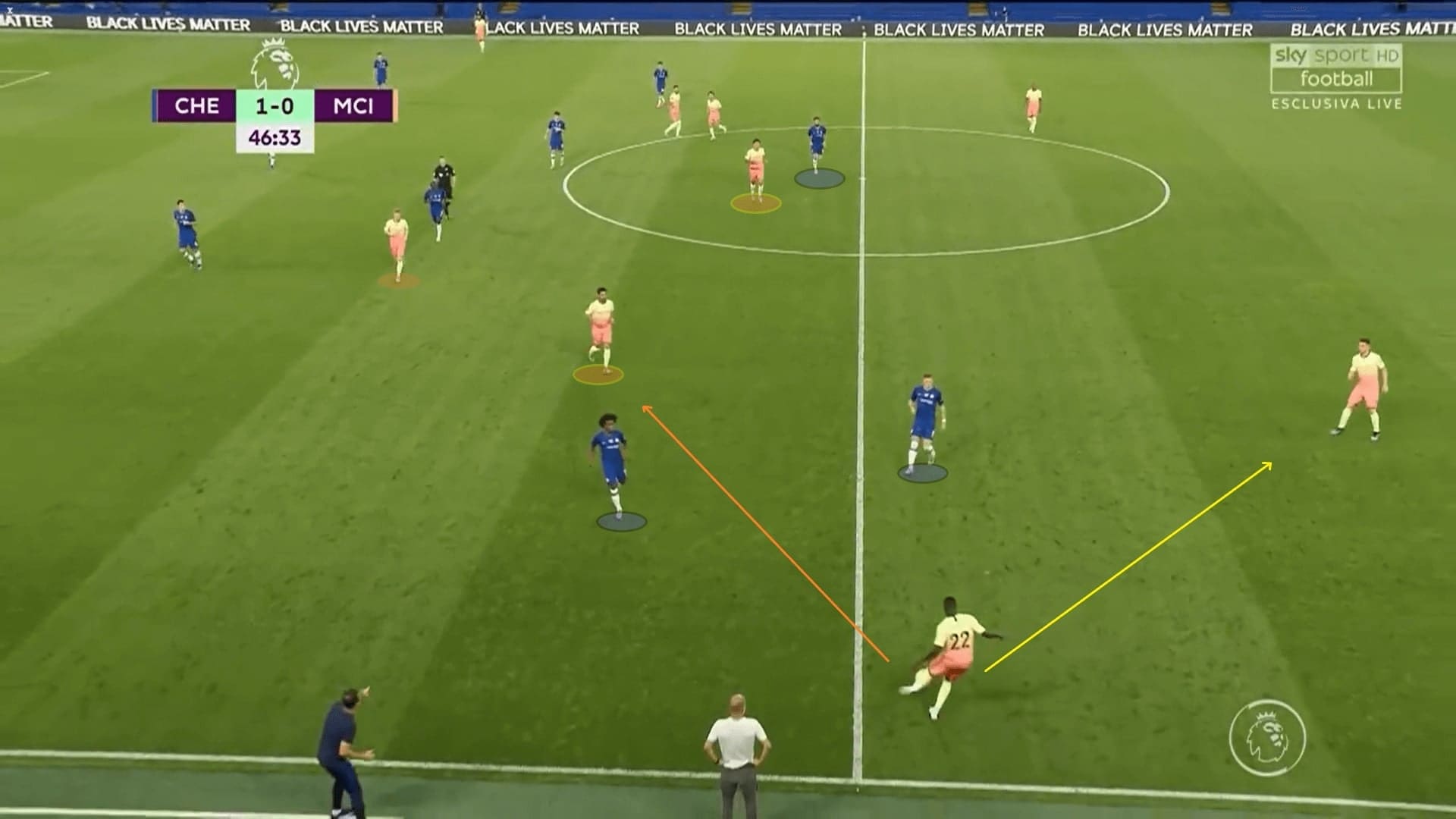
As mentioned, the disciplined midblock minimised the impact of City’s disruption on the second line. This was still okay as Fernandinho was given the chance to play the out-ball. Why I said City need a traditional striker was because of the poor control of the last line.
Traditionally, a striker stays with the last defenders and attacks spaces behind. If not, at least he keeps the defenders away from midfield by maximizing his positional superiority. This was the element City were missing in this game.
On some occasions, City progressed play, but the high receiver was under pressure from the stepping up defenders, even the centre-backs. Here, Sterling found the third man: Rodri because Andreas Christensen was pressuring him.
The centre-back has stepped up! Spaces were available behind, the third man should have easily played a through ball to exploit those areas. However, these opportunities were wasted as City players were reluctant to make runs behind the defence. As an example, Mahrez should go behind the defence now, but he stood still.
Situations like these always forced City to restart an attack, while offering time for Chelsea to reorganise the solid midblock.
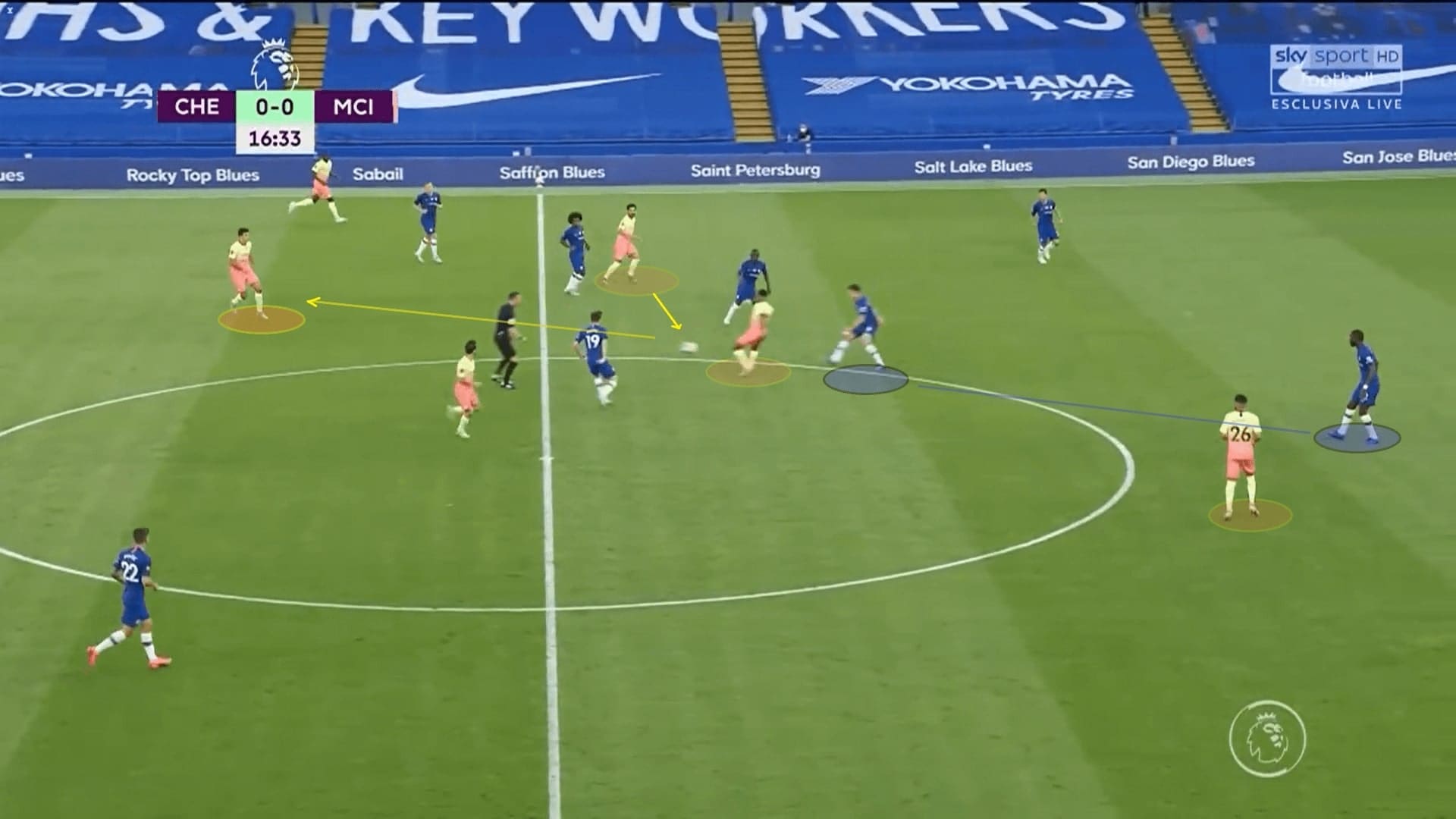
A similar situation below, Mahrez clearly had an advantage against Alonso in the 1 v 1s. Cutting inside was the trademark skill of the Algerian winger, but what he needed was spaces to carry the ball into.
Here, De Bruyne should have gone behind or diagonally to exploit the blindside of Rüdiger. They had to make the centre-backs pay the cost of stepping out! Sadly, the Belgian international remained static and Mahrez lost the ball in this difficult 1 v 2.
Similar scenarios hindered City to create meaningful chances, as Chelsea just committed numbers to suffocate the attack with numbers or physical superiority. Even when they got the best players – Sterling, De Bruyne and B. Silva – on the ball, the sustainability of the attack was low as a centre-back always stuck to the receiver.
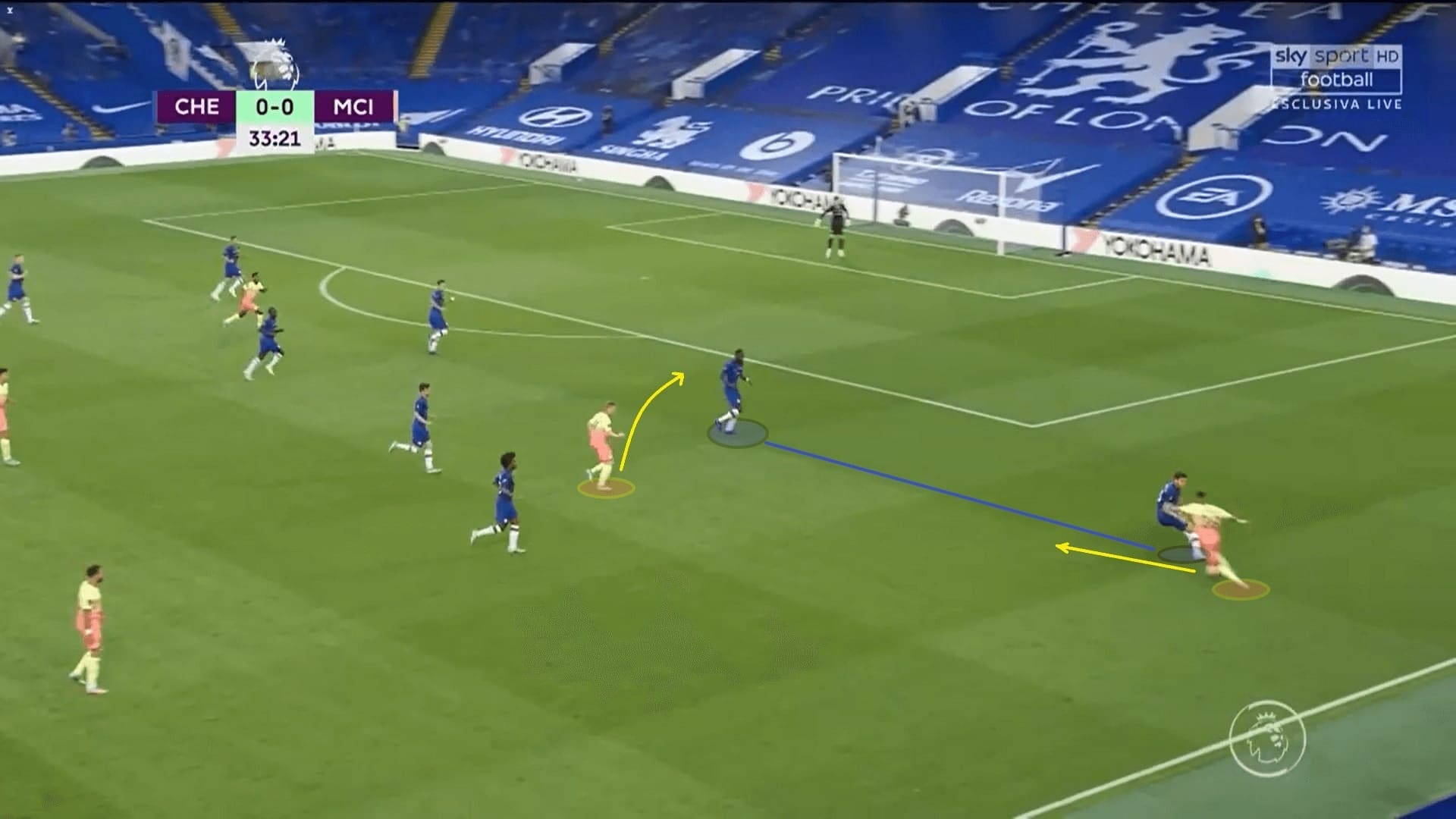
Briefly concluding, the City players were a bit confused by the tasks as the highest point of the attack varied across situations. For example, when B. Silva dropped, Mahrez, Sterling or De Bruyne would fill that point but the positions might be suboptimal (far from centre initially). Even when the position was fine, as explained, they were not attacking spaces behind the line.
This was a difficult tactic and the players have to be extremely clever and focused to execute. Maybe it could be successful on a different day.
An easy press to beat
Guardiola has been changing his tactics to improve the team, we have no doubt in this. A new element that he brought in after the break was the pressing system of City. In the Arsenal game, City have already shown their 4-3-3 pressing shape, which was different from the 4-4-2 shape they used before.
It was a conceivable change as the average PPDA of City was the highest since the 2017/18. Guardiola tweaked the defensive setups to avoid the reoccurring issues such as spaces behind the full-backs.
By having B. Silva shadow Kanté in the first phase, City wanted the Blues to play the ball to the flanks and win it there.
Ideally, City wanted to force long balls by pressing. Both teams were playing in a 4-3-3, the defending team could just mirror the personnel and numerical equality should be achieved easily. Although Giroud was good in the air, the away team had two central defenders (Laporte and Fernandinho), which ensured the initial ball and second balls were won safely.
An example here, we highlighted the 3 v 3 wide defence of City. Similar to Mahrez’s and Sterling’s case, Pulisic also received the ball with a closed body shape because of Walker’s pressure. The press of City forced quick plays and the quality was not guaranteed.
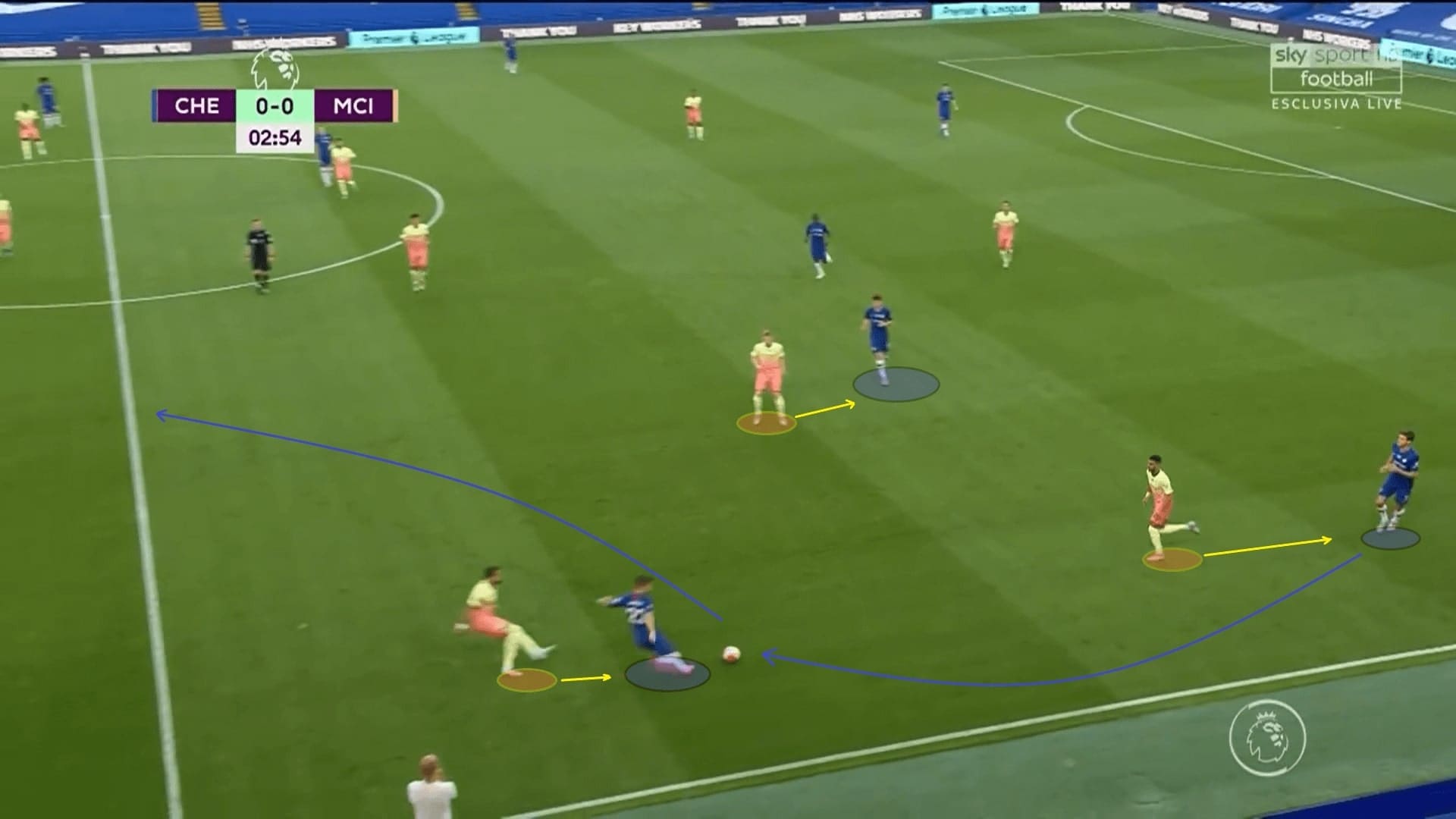
However, the above case was only one of a few successful pressings of City. Instead, the structural issue was unsolvable. Note the 4-3-3 shape below, and this block was fragile in the wide areas.
Assuming they’re keeping the first line at the centre, this means De Bruyne and Gündoğan had to cover the wide areas, and how can a three-man second line of City cover such a big ground horizontally?
Also, using B. Silva to shadow Kanté means setting the centre-backs free. Rüdiger and Christensen were playing some fruitful long balls purposefully. These passes either hit the wide areas, like Rüdiger releasing Willian here, or they will reach Giroud, and Pulisic looked to pick the second balls and run towards the defence.
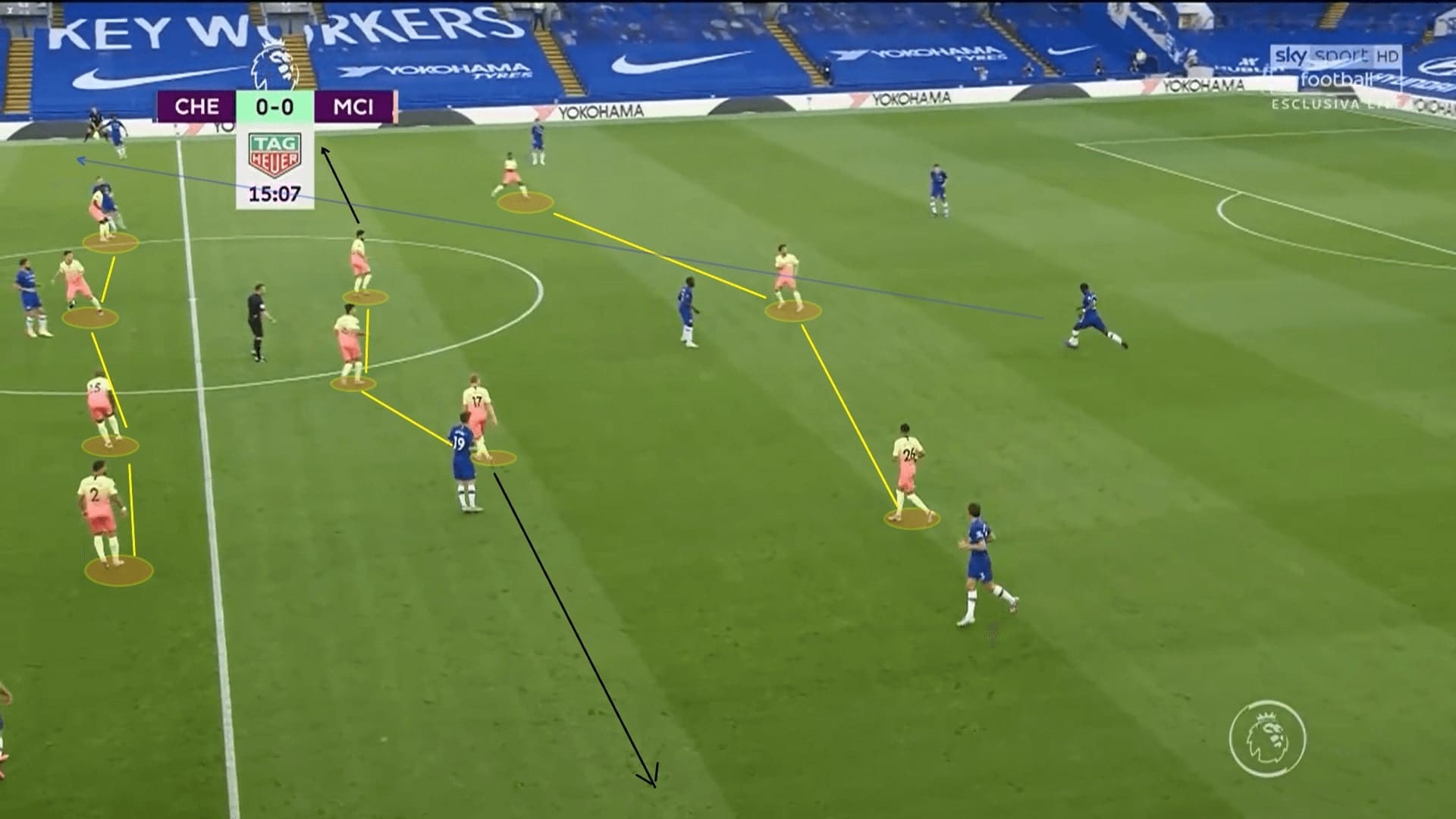
If you’re committing a winger to press the centre-back, what will happen? The full-back will become the free man. Of course, Chelsea were clever and avoided passing to the full-back directly. The third man plays and lofted balls were used more often as a tool to reach them.
As an example, Sterling pressed Christiansen here, leaving César Azpilicueta unmarked. Christensen passed to Kanté, and this was another detail which City executed poorly. Yes, B. Silva was on the Frenchman, but the pressure was never imminent. A simple third man play already bypassed the pressure and the first line.
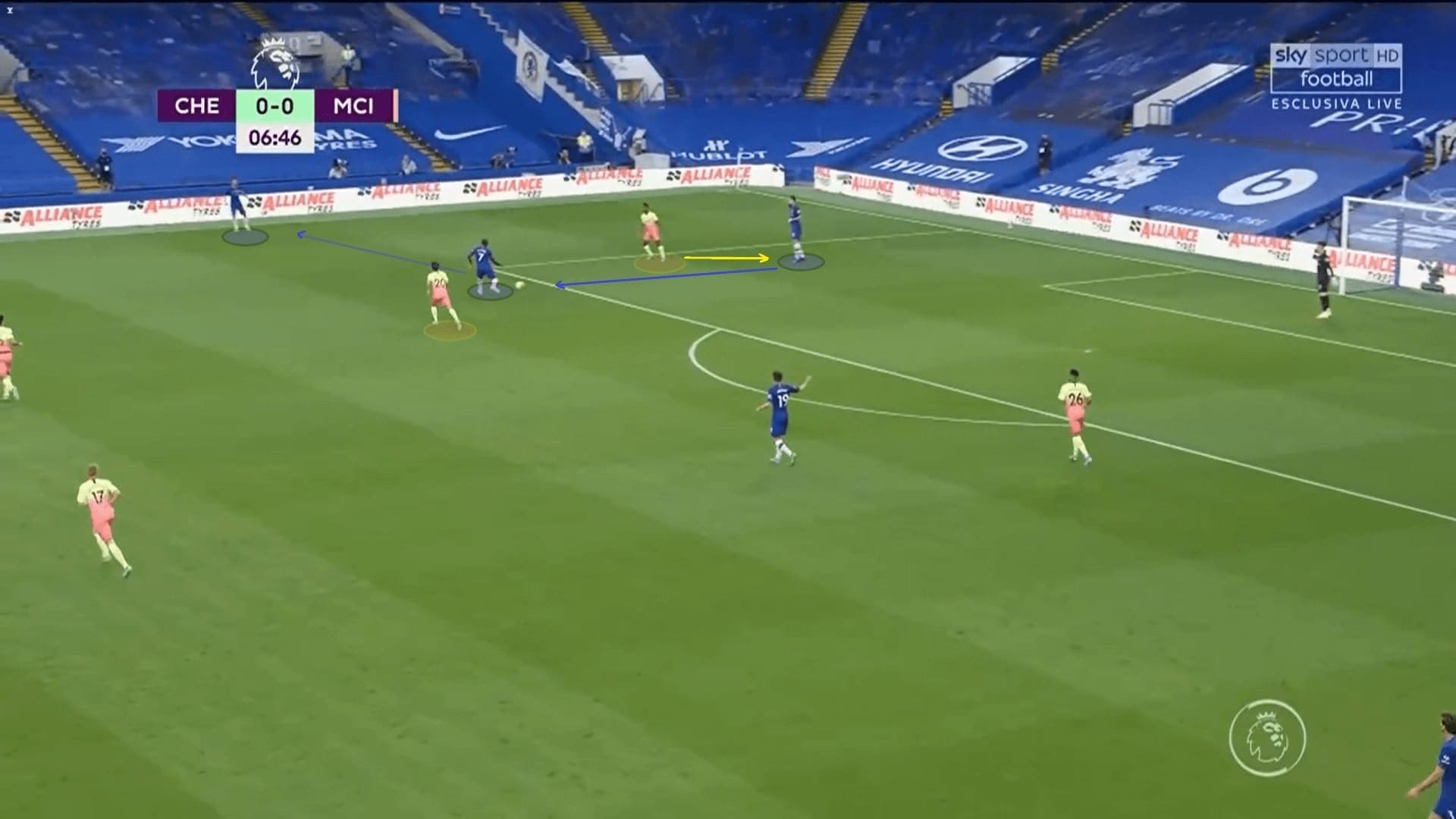
The remaining personnel in the press to match the players numerically on the flank were the wide midfielders of City. Recalling the image that showed the 4-3-3 shape of City, could you imagine how far were Gündoğan or De Bruyne from reaching the touchline?
It was very far. After several successful third man plays of Chelsea, Gündoğan and De Bruyne tried to be clever and moved wide earlier. However, the Blues were smarter to avoid these pressing traps and exposed spaces between the lines.
Here, De Bruyne moved wide early to approach Alonso, but Kanté played an excellent vertical pass to Mount, who was exploiting spaces left by De Bruyne. Walker could not do anything as the winger often occupied him. Again, we question why Kanté could play the ball easily as B. Silva was there already.
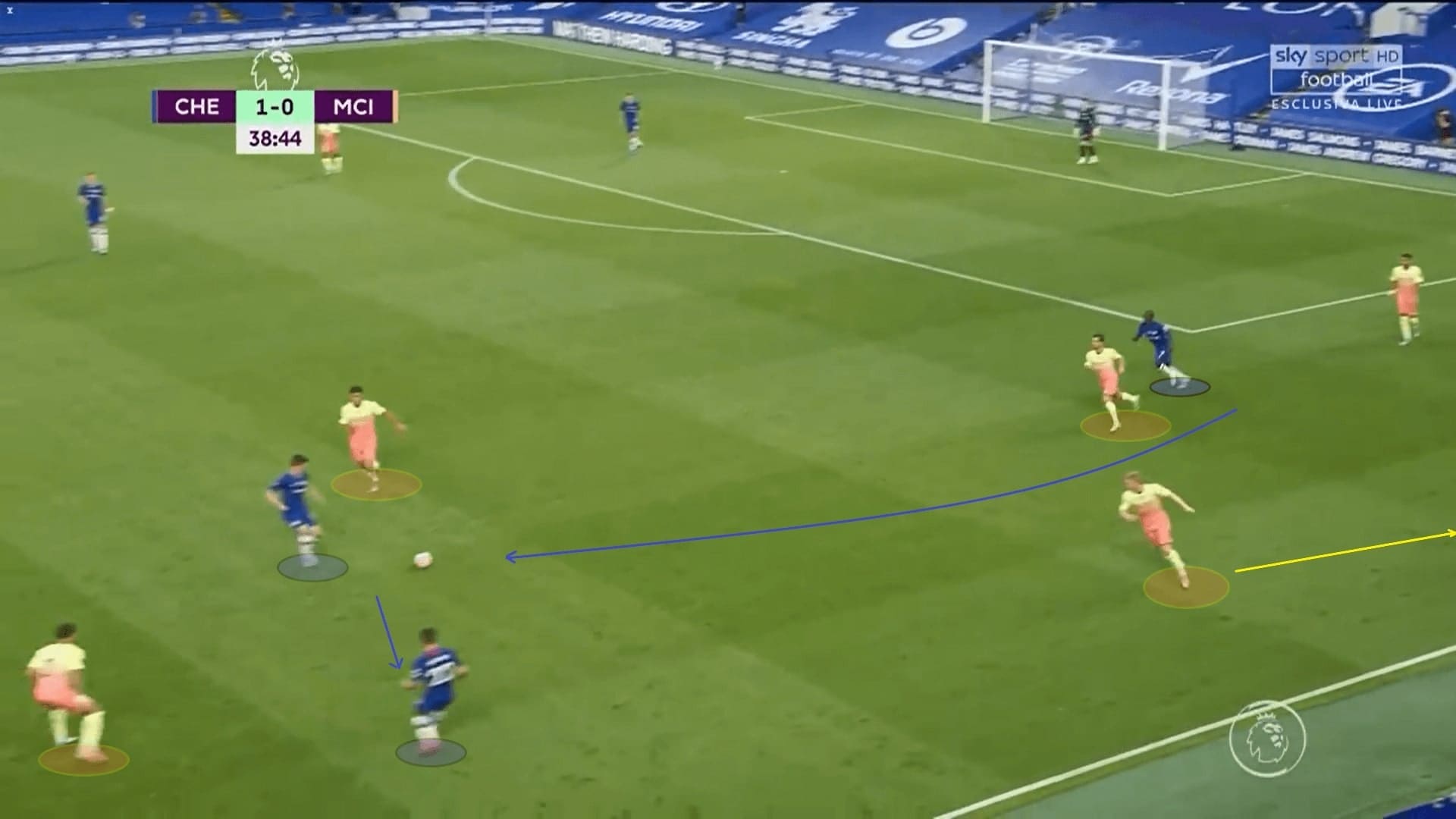
Chelsea’s offensive success
We are briefly explaining Chelsea’s offensive style of play here, which should give you a clearer picture of how they nailed the victory.
This graph was the pass map of the Blues and we want to show the wide positionings of the full-backs. As explained above, they were the perfect route to escape the press from City. The connections at flanks were much larger than the centre.
Also, notice the positionings of Pulisic and Willian, who inverted centrally at times to look for the second balls. You may wonder what if City used the full-back to press the wide player. In fact, this would lead to a more catastrophic result as Pulisic would be facing Fernandinho directly, a mismatch and undoubtedly, he could outpace the Brazilian defender.
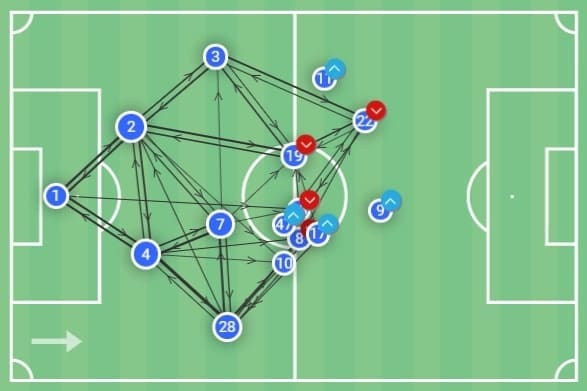
A further elaborated example of Chelsea’s first phase here. Christensen, Kepa Arrizabalaga and Rüdiger formed the first line and Kanté must provide the second layer. The shape was opened very early by using the full-backs to occupy the wide zone, leaving the three central zones for the central defenders and the keeper.
Since the keeper was used as an additional man, Chelsea must have numerical superiority, like an 8 v 6 here. The first line had the confidence to circulate the ball smoothly, and seizing the timing to find the full-back.
Again, note the distance De Bruyne must cover to reach Alonso and he could not go too soon as this would leave spaces in front of the defence opened. It was a dilemma.
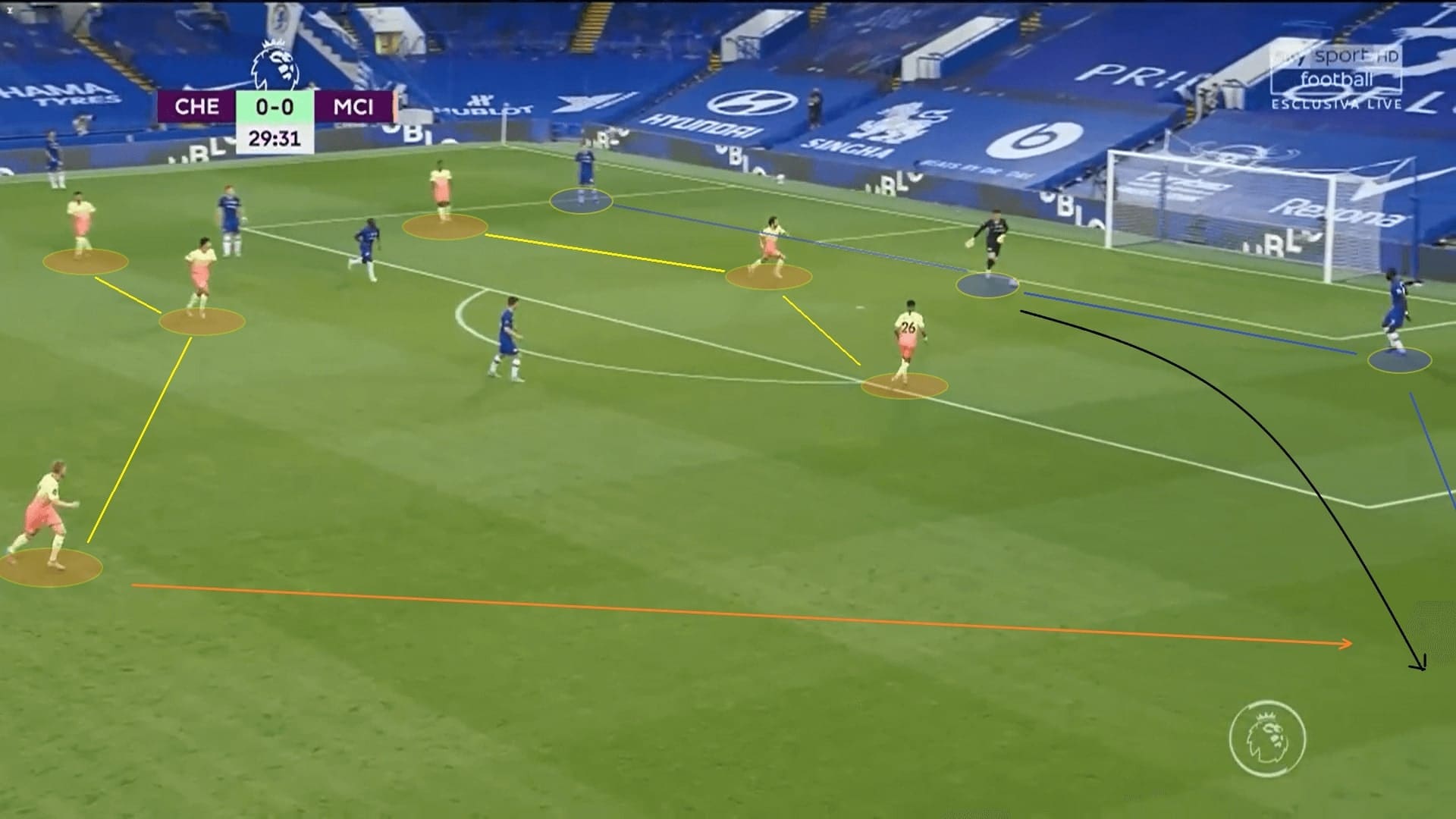
Another image we show here is the heat map of Giroud. Unsurprisingly, he served as a target man for Chelsea. This was reflected by his heavy presence at the central third, where he engaged in duels against Fernandinho or Laporte.
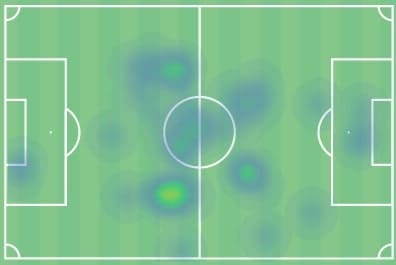
Changes in the second half
Given the above pros and cons of the setups, both teams had a slight tweak of their tactics in the second half. Guardiola changed more as his team needed some changes to get back into the game.
Defensively, the Kanté issue was eased by committing the pivot. This freed the striker to press the centre-back, improving the control of the ball directions.
Here, Rodri stepped up to match Kanté, so B. Silva could press Christensen and guide the ball to Azpilicueta. The right-back was quickly under pressure from Sterling and played long without a clear purpose, City could win the ball back.
However, despite all these changes, the physical mismatches of the likes of Pulisic and Abraham were inevitable. These have led to several direct chances of Chelsea and a red card.
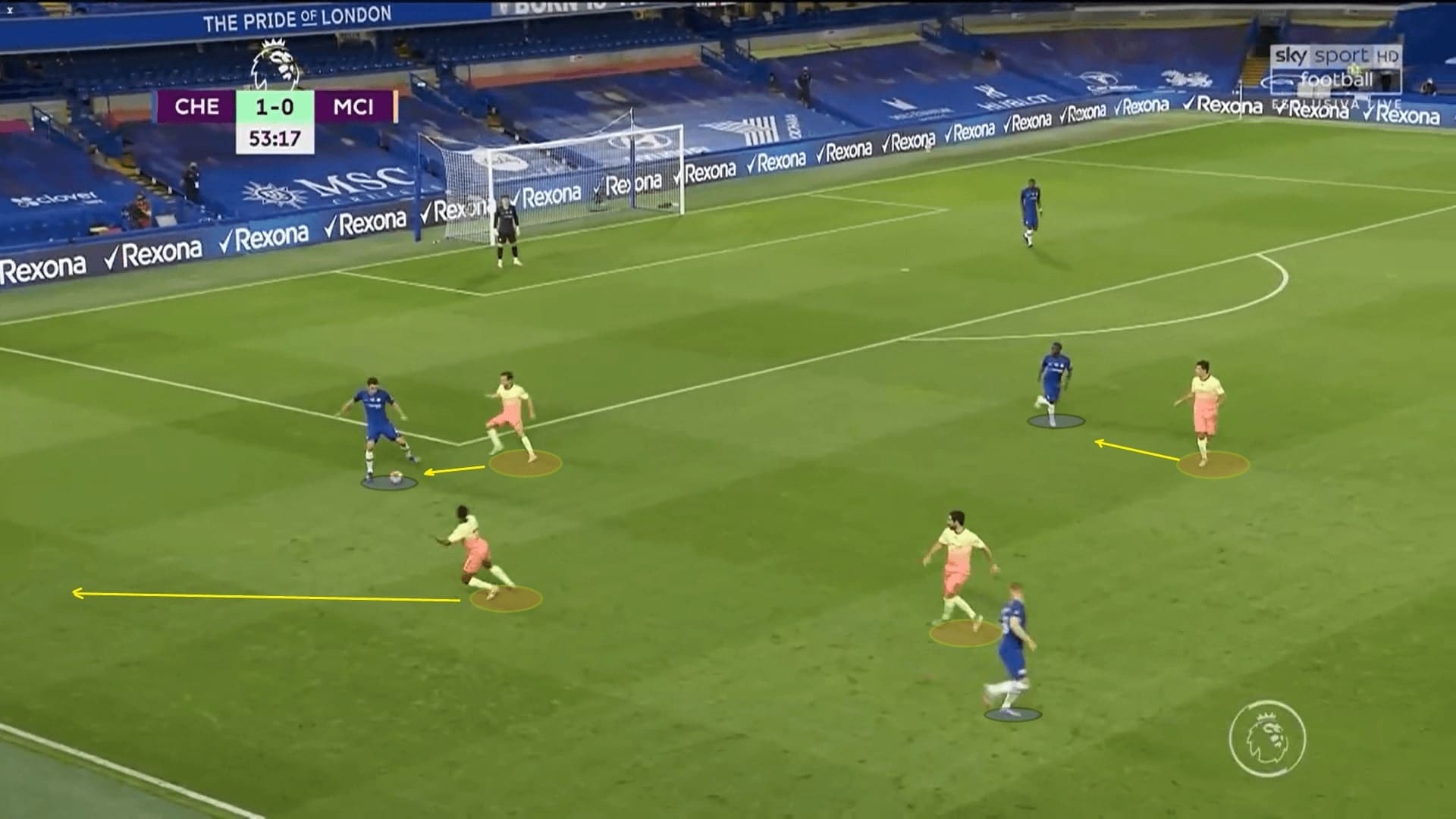
Offensively, City introduced Jesus and D. Silva to replace Gündoğan and B. Silva. The Brazilian added a player with heavier striker mindset, but still, he served as the “false-9” at times and the issue (behaviour to control the last line) was still there. Playing D. Silva was adding a player to operate at the half-spaces and connecting with the City wingers.
In the first phase, especially after Oleksandr Zinchenko came on, City inverted the full-backs to add an extra man in the midfield. Therefore, the directly passing lanes to wingers were opened and City thought they could create the dynamics at flanks. Here, Walker could pass to Mahrez directly.
However, the Algerian winger was too deep to receive the ball, and you could see Mount and Kanté already adjusted the body shapes to overload the flank. Credits should be given to Mount, as he covered his corresponding target no matter who was that player. Despite all these changes, City were still struggling to generate chances.
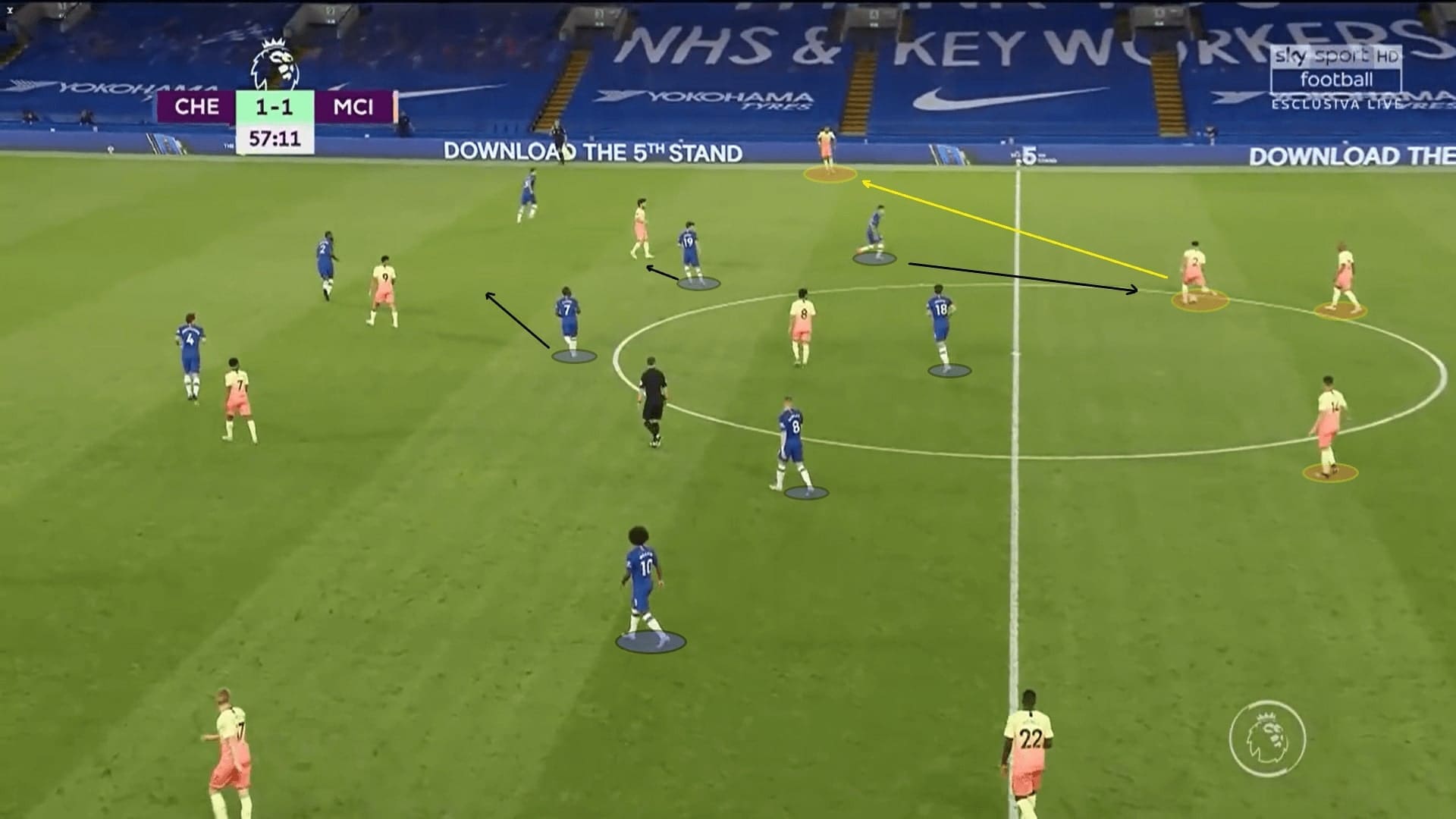
Not many huge changes from Lampard. A wise substitution was to use Tammy Abraham to replace Giroud. Chelsea #9 was quick, hardworking but also has a certain level of body strength.
Defensively, he also pressured Fernandinho at times and forced City to play some long balls. So, when he pushed higher, the Chelsea midfielder would cover spaces behind. Gaps between players increased but it was not an issue as City were unable to find the free man in this game.
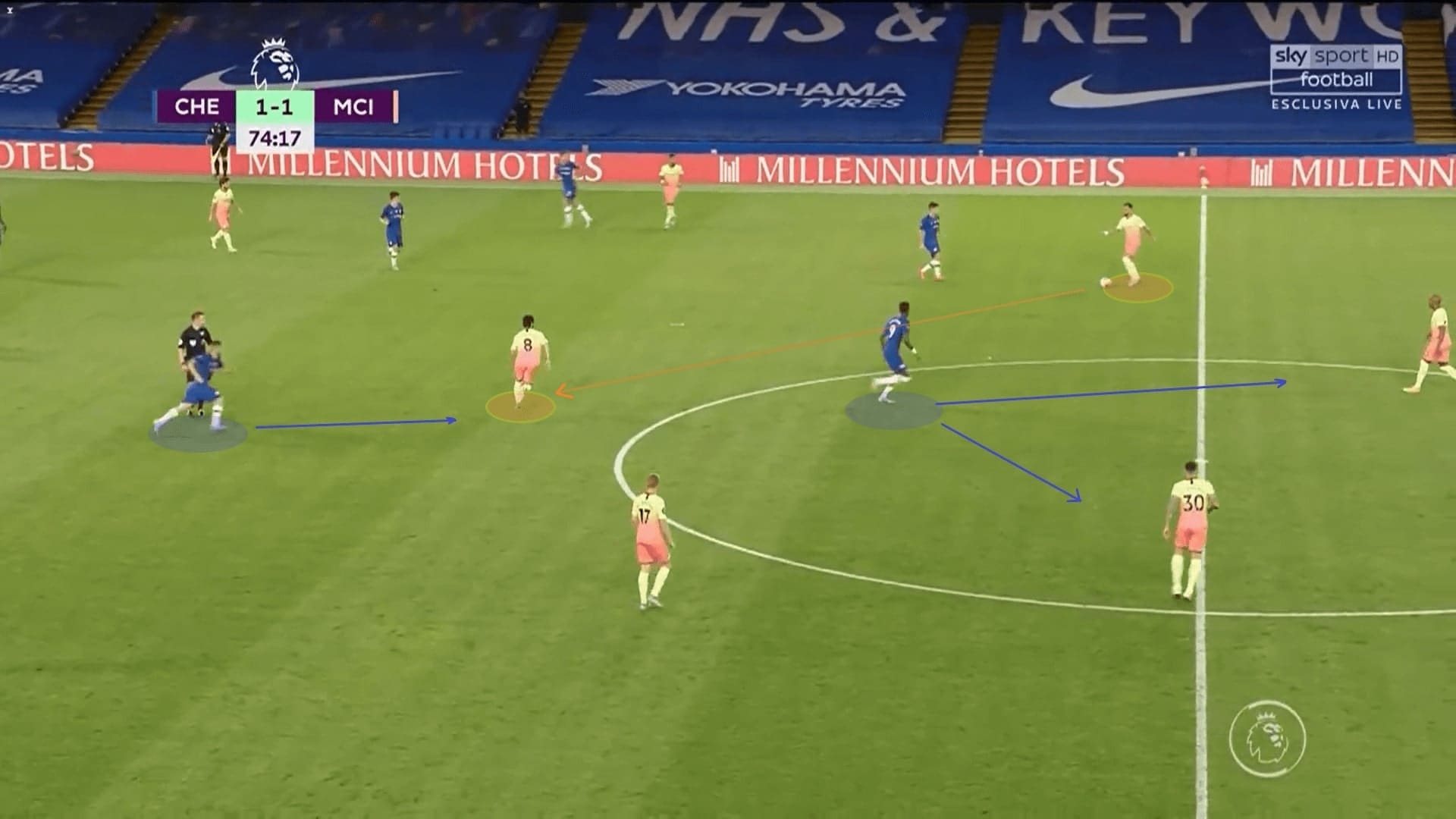
Final remarks
Although Guardiola has said this game was okay in general, I’m afraid even he is not believing this. When we take a look at the stats, it gives us more hints on the poor City open play performance – only 0.25 xG from their 0.49 xG was generated out of corners and freekicks.
Chelsea have prepared hard, and also adjusted some tactical details such as marking De Bruyne tighter. However, what helped them to obtain the victory was the physical superiority, the better structure, execution, and a bit of luck – Sterling nearly took the lead for City. But football is football, sometimes things like this happen, still, a well-deserved victory for the Blues.





Comments